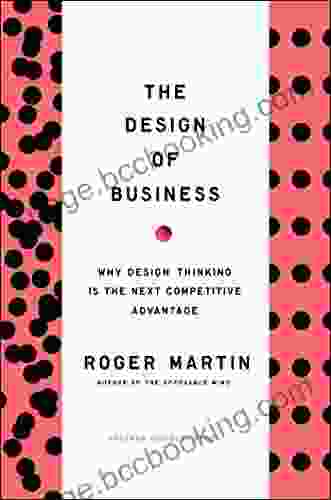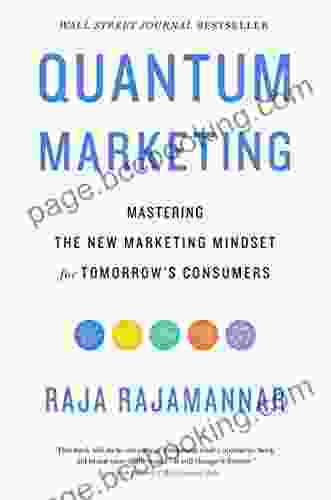Why Design Thinking Is the Next Competitive Advantage

In today's competitive business landscape, it's more important than ever to find ways to stand out from the competition. One way to do this is to embrace design thinking, a human-centered approach to problem-solving that can help you create innovative products and services that meet the needs of your customers.
Design thinking is not just about making things look pretty. It's about understanding the underlying human needs that drive behavior. By understanding these needs, you can create solutions that are both effective and desirable.
4.5 out of 5
| Language | : | English |
| File size | : | 794 KB |
| Text-to-Speech | : | Enabled |
| Screen Reader | : | Supported |
| Enhanced typesetting | : | Enabled |
| X-Ray | : | Enabled |
| Word Wise | : | Enabled |
| Print length | : | 160 pages |
There are five key stages to the design thinking process:
- Empathize: Understand the needs of your users by observing them in their natural environment.
- Define: Clearly define the problem you are trying to solve.
- Ideate: Brainstorm a wide range of possible solutions.
- Prototype: Build a prototype of your solution to test it with users.
- Test: Gather feedback from users and iterate on your solution until it meets their needs.
Design thinking can be used to solve a wide range of problems, from developing new products and services to improving existing ones. It can also be used to address social and environmental issues.
Here are a few examples of how design thinking has been used to create successful products and services:
- The Apple iPhone: The iPhone was designed with a focus on simplicity and ease of use. It has a sleek design and an intuitive interface that makes it easy to use for people of all ages.
- The Airbnb website: Airbnb is a website that allows people to rent out their homes or apartments to travelers. The website was designed with a focus on making it easy for people to find and book accommodations.
- The TOMS Shoes company: TOMS Shoes is a company that sells shoes that are made from recycled materials. The company was founded with a mission to provide shoes to children in need. For every pair of shoes that TOMS sells, it donates a pair of shoes to a child in need.
These are just a few examples of how design thinking can be used to create innovative products and services. If you're looking for a way to gain a competitive advantage, design thinking is a great place to start.
How to Get Started with Design Thinking
If you're interested in getting started with design thinking, there are a few things you can do:
- Read books and articles about design thinking. There are a number of great books and articles available that can teach you the basics of design thinking.
- Take a design thinking workshop. There are many workshops available that can teach you the design thinking process and how to apply it to your work.
- Start practicing design thinking on your own. You can start practicing design thinking on your own by following the five stages of the design thinking process.
Design thinking is a powerful tool that can help you create innovative products and services that meet the needs of your customers. If you're looking for a way to gain a competitive advantage, design thinking is a great place to start.
Why Design Thinking Is the Next Competitive Advantage
In today's competitive business landscape, it's more important than ever to find ways to stand out from the competition. One way to do this is to embrace design thinking, a human-centered approach to problem-solving that can help you create innovative products and services that meet the needs of your customers.
Here are a few reasons why design thinking is the next competitive advantage:
- Design thinking helps you understand the needs of your customers. By understanding the underlying human needs that drive behavior, you can create solutions that are both effective and desirable.
- Design thinking promotes innovation. By brainstorming a wide range of possible solutions, you can come up with ideas that you would never have thought of otherwise.
- Design thinking reduces risk. By prototyping and testing your solutions with users, you can get feedback and iterate on your design until it meets their needs.
- Design thinking builds stronger relationships with customers. By involving customers in the design process, you can build trust and loyalty.
If you're looking for a way to gain a competitive advantage, design thinking is a great place to start. By embracing design thinking, you can create innovative products and services that meet the needs of your customers and build stronger relationships with them.
4.5 out of 5
| Language | : | English |
| File size | : | 794 KB |
| Text-to-Speech | : | Enabled |
| Screen Reader | : | Supported |
| Enhanced typesetting | : | Enabled |
| X-Ray | : | Enabled |
| Word Wise | : | Enabled |
| Print length | : | 160 pages |
Do you want to contribute by writing guest posts on this blog?
Please contact us and send us a resume of previous articles that you have written.
 Book
Book Novel
Novel Page
Page Chapter
Chapter Text
Text Story
Story Genre
Genre Reader
Reader Library
Library Paperback
Paperback E-book
E-book Magazine
Magazine Newspaper
Newspaper Paragraph
Paragraph Sentence
Sentence Bookmark
Bookmark Shelf
Shelf Glossary
Glossary Bibliography
Bibliography Foreword
Foreword Preface
Preface Synopsis
Synopsis Annotation
Annotation Footnote
Footnote Manuscript
Manuscript Scroll
Scroll Codex
Codex Tome
Tome Bestseller
Bestseller Classics
Classics Library card
Library card Narrative
Narrative Biography
Biography Autobiography
Autobiography Memoir
Memoir Reference
Reference Encyclopedia
Encyclopedia P A Thomson
P A Thomson Ron Osajima
Ron Osajima Roger L Martin
Roger L Martin Rick Brandon
Rick Brandon Vincent Norman
Vincent Norman Tracy Salcedo
Tracy Salcedo Olivier Doleuze
Olivier Doleuze Rae Simons
Rae Simons Shannon Ables
Shannon Ables Sara Campbell
Sara Campbell Peter Parr
Peter Parr Pixie Unger
Pixie Unger Patricia Sands
Patricia Sands Phil C Senior
Phil C Senior Suzanne Schlosberg
Suzanne Schlosberg Nobu Matsuhisa
Nobu Matsuhisa Tristan Jones
Tristan Jones Raja Shehadeh
Raja Shehadeh Robert Richard
Robert Richard Norman Bridwell
Norman Bridwell
Light bulbAdvertise smarter! Our strategic ad space ensures maximum exposure. Reserve your spot today!
 Kirk HayesFollow ·9.3k
Kirk HayesFollow ·9.3k Roald DahlFollow ·17.8k
Roald DahlFollow ·17.8k Robin PowellFollow ·9.4k
Robin PowellFollow ·9.4k George OrwellFollow ·19.8k
George OrwellFollow ·19.8k Christian BarnesFollow ·11.9k
Christian BarnesFollow ·11.9k Morris CarterFollow ·15k
Morris CarterFollow ·15k Mark TwainFollow ·3k
Mark TwainFollow ·3k Harrison BlairFollow ·12k
Harrison BlairFollow ·12k

 Marvin Hayes
Marvin HayesGoverning Law for Law School and Bar Exam Prep: Your...
Unlock the Secrets of...

 Sidney Cox
Sidney CoxUnveiling the Epic Tales of Whiskey, War, and Military...
In the tapestry of history,...

 Victor Turner
Victor TurnerGoverning Law for Law School and Bar Exam Prep: The...
What is Governing...

 Robert Browning
Robert BrowningSterling Test Prep MCAT General Chemistry Practice...
: Embark on Your MCAT General Chemistry...
4.5 out of 5
| Language | : | English |
| File size | : | 794 KB |
| Text-to-Speech | : | Enabled |
| Screen Reader | : | Supported |
| Enhanced typesetting | : | Enabled |
| X-Ray | : | Enabled |
| Word Wise | : | Enabled |
| Print length | : | 160 pages |
















